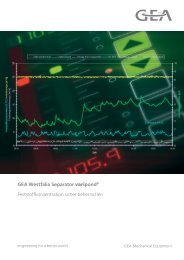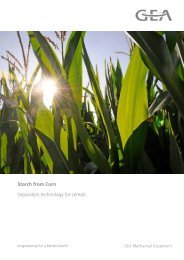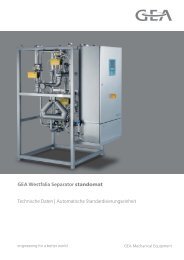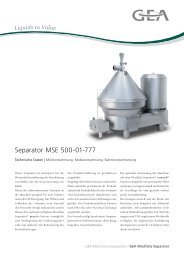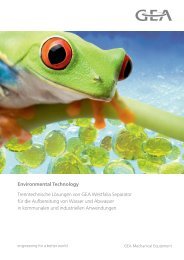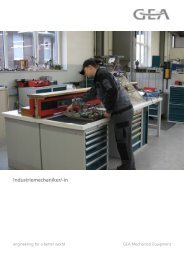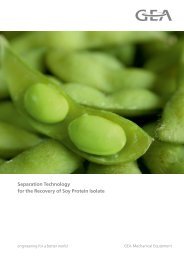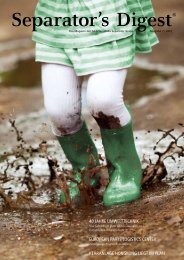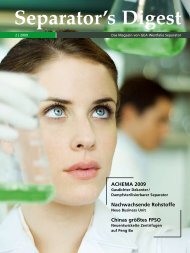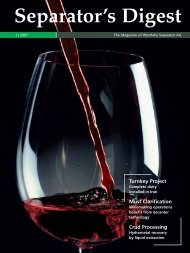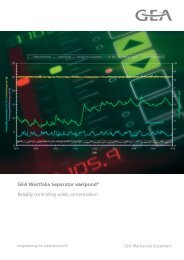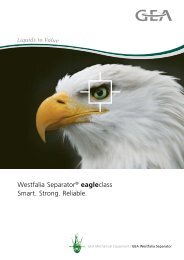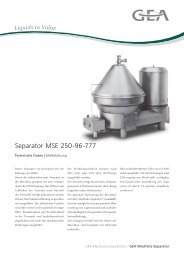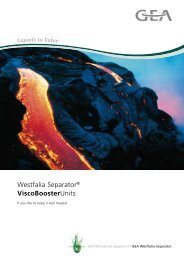Separator's Digest 2009/1 min. - GEA Westfalia Separator Group
Separator's Digest 2009/1 min. - GEA Westfalia Separator Group
Separator's Digest 2009/1 min. - GEA Westfalia Separator Group
Create successful ePaper yourself
Turn your PDF publications into a flip-book with our unique Google optimized e-Paper software.
<strong>Separator</strong>’s <strong>Digest</strong><br />
1 | <strong>2009</strong><br />
Anuga FoodTec <strong>2009</strong><br />
New Drive Concept for<br />
Dairy <strong>Separator</strong>s<br />
Butter and Butter Oil<br />
Special Applications of Dairy Technology<br />
”Investment in Ideas“<br />
Groundbreaking Ceremony for the<br />
Production Centre of the Future<br />
The Magazine of <strong>GEA</strong> <strong>Westfalia</strong> <strong>Separator</strong>
Contents<br />
3<br />
preface<br />
3 Gea <strong>Westfalia</strong> <strong>Separator</strong> process:<br />
Bundling of activities<br />
<strong>Separator</strong>’s <strong>Digest</strong> 1 | <strong>2009</strong><br />
Gea WeSTfaLIa SeparaTor<br />
4 one Day makes History: 8th 4<br />
December 2008<br />
2<br />
8 SeparaTor´S NeWS<br />
8 Topical<br />
Imprint<br />
The information contained in this brochure merely serves as a<br />
non-binding description of our products and is without guarantee.<br />
Binding information, in particular relating to capacity data and<br />
suitability for specific applications, can only be provided within the<br />
framework of concrete inquiries.<br />
<strong>GEA</strong> <strong>Westfalia</strong> <strong>Separator</strong><br />
12 Gea WeSTfaLIa<br />
SeparaTor proceSS<br />
12 The pride of Development: Integrated Direct Drive<br />
14 clarifying Decanter Gce 345 in compact Design<br />
16 Very Successful cold milk process<br />
18 already a classic: <strong>Westfalia</strong> <strong>Separator</strong> proplus<br />
20 Butter and Butter oil<br />
23 Turning costs into profit<br />
26 Now also available in the WeB portal<br />
28<br />
Publisher:<br />
Gea <strong>Westfalia</strong> <strong>Separator</strong> GmbH<br />
project management: peter arens<br />
Gea WeSTfaLIa<br />
SeparaTor SYSTemS<br />
28 power for casablanca<br />
30 recovering crude oil from<br />
oil Lagoons<br />
32 Tannery Waste Water<br />
34 LIfeSTYLe<br />
34 fine Vintage<br />
Editors:<br />
peter arens (person responsible<br />
according to the German press Law),<br />
Dr. Jörg Bückle, manfred Kaiser<br />
Photography:<br />
michael Dannenmann, Tim Luhmann,<br />
archive Gea <strong>Westfalia</strong> <strong>Separator</strong> GmbH<br />
Conception and Layout:<br />
Kabutz communication GmbH<br />
feldstraße 5 · 59423 Unna<br />
info@kabutz.de · www.kabutz.de
Gea <strong>Westfalia</strong> <strong>Separator</strong> process:<br />
Bundling of activities<br />
The new Gea <strong>Westfalia</strong> <strong>Separator</strong> process<br />
will present itself in this form at the<br />
anuga foodTec in cologne. It pools<br />
process skills, innovation potential and sales<br />
activities under one roof. This means<br />
that synergy effects can be utilised and<br />
internal coordination and decision-making<br />
processes are shortened. our time-to-<br />
market is enhanced; it is not only possible<br />
for process engineering solutions to be<br />
advanced more rapidly; they also constitute<br />
a better grounding for new developments<br />
and innovations. This means that<br />
the centrifugal separation technology of<br />
Gea <strong>Westfalia</strong> <strong>Separator</strong> becomes a key<br />
world-wide technology for modern<br />
sustainable production of milk and dairy<br />
products, beverages, starch, protein,<br />
pharmaceutical products, chemicals,<br />
<strong>min</strong>erals, vegetable oils and other essential<br />
products.<br />
four Business Units form the backbone<br />
of the new Gea <strong>Westfalia</strong> <strong>Separator</strong> process:<br />
Dairy Technology, Beverage Technology,<br />
chemical / pharmaceutical Technology and,<br />
as a new entity, the Business Unit renewable<br />
resources. This Business Unit comprises<br />
everything related to the growth market of<br />
renewable raw materials. The synergies of<br />
the current activities are also pooled in this<br />
unit, which means that the markets now<br />
have a specific contact who is available for<br />
process engineering developments. This is<br />
applicable for the first generation of<br />
sustainable raw materials, such as bioethanol<br />
or biodiesel as well as the second and third<br />
generations of fuel energy and the recovery<br />
of raw materials on the basis of biomasses.<br />
With their new structure and as a result of<br />
expanding their market fields, the specialist<br />
Business Units now operate more closely<br />
with our markets and customers, and<br />
thus provide solutions which are even<br />
more precisely tailored to meet the needs<br />
and requirements of our customers. our<br />
customers are able to benefit from<br />
concentrated innovative strength for new<br />
applications, optimum separating and<br />
<strong>GEA</strong> <strong>Westfalia</strong> <strong>Separator</strong><br />
aS a reSULT of BUNDLING THe<br />
Gea WeSTfaLIa SeparaTor SaLeS<br />
compaNIeS fooD Tec aND INDUSTrY<br />
To form THe NeW aND HIGHLY<br />
effIcIeNT Gea WeSTfaLIa SeparaTor<br />
proceSS, We are meeTING<br />
THe cHaLLeNGeS of THe marKeTS for<br />
THe BeNefIT of oUr cUSTomerS.<br />
<strong>Separator</strong>’s <strong>Digest</strong> 1 | <strong>2009</strong><br />
clarifying results for maximum product<br />
yields, better process efficiency and<br />
improved availability of installations. That is<br />
your benefit and our mission.<br />
We are looking forward to presenting our<br />
concept to you at anuga foodTec <strong>2009</strong>.<br />
Holger Heinrich<br />
Division president<br />
Preface
<strong>GEA</strong> <strong>Westfalia</strong> <strong>Separator</strong><br />
Holger Heinrich: ”Not an investment merely in buildings<br />
and machines, but rather also an investment in the ideas<br />
and commitment of our staff.“<br />
<strong>GEA</strong> WEstfAliA sEpArAtor lAunchEs A<br />
160 Million Euro invEstMEnt proGrAMME With<br />
A cElEbrAtory GroundbrEAkinG cErEMony<br />
one day Makes<br />
8 th december 2008<br />
8 th december in oelde was certainly symbolic. it seemed almost as if <strong>GEA</strong> <strong>Westfalia</strong><br />
separator wanted not only to celebrate but also to impressively visualise the start of a<br />
new era on this day. As such, whilst a crane moved into position to demolish the old<br />
brick chimney from 1915 on one side of the site, the groundbreaking ceremony for the<br />
production centre of the future was beginning on the other side. <strong>GEA</strong> <strong>Westfalia</strong> separator<br />
will be investing no less than around 90 million Euro in this project in oelde alone and<br />
around 160 million Euro around the world.<br />
the largest ever single investment in the company head office comprises one third<br />
building investment and two thirds investment in machines and test bay technology. in<br />
addition, there will also be sustainable expansion of the process engineering.<br />
<strong>Separator</strong>’s <strong>Digest</strong> 1 | <strong>2009</strong><br />
<strong>GEA</strong> <strong>Westfalia</strong> <strong>Separator</strong><br />
A force together (from left to<br />
right): Jürg Oleas (President of<br />
<strong>GEA</strong> <strong>Group</strong> Aktiengesellschaft),<br />
Principal Karl-Uwe Bütof<br />
(Department of Trade and Industry<br />
NRW), Mayor Helmut Predeick<br />
(City of Oelde) and Holger Heinrich<br />
(President Mechanical Separation<br />
Technology Division) during the<br />
groundbreaking ceremony.
history
<strong>GEA</strong> <strong>Westfalia</strong> <strong>Separator</strong><br />
”An Investment in Ideas“<br />
Jürg oleas: ”We are focusing on the specific potential<br />
of German mechanical engineering.“<br />
the official event was opened by the <strong>GEA</strong> <strong>Group</strong> division president<br />
for mechanical separation technology holger heinrich. in the<br />
speeches, both the representative of the department of trade and<br />
industry of the federal state of north rhine Westphalia, principal<br />
karl-uwe bütof, and Mayor of the city of oelde, helmut predeick,<br />
commended the significant investment in the location of Germany.<br />
particularly in the currently increasingly difficult times, securing<br />
existing innovation potential and jobs is an important signal for the<br />
entire German economy. “if we are investing 90 million Euro, it is<br />
not an investment merely in buildings and machines, but rather also<br />
an investment in the ideas and commitment of our staff,” explained<br />
holger heinrich, “as oelde has been, is, and remains the heart and<br />
backbone of the company.”<br />
More effective, quicker<br />
and closer to the customer<br />
increasing efficiency at the oelde site through modernisation<br />
and by focusing production on the construction of separators<br />
should be at the forefront of the investment programme. in the<br />
future, production of the recognised high quality of <strong>GEA</strong> <strong>Westfalia</strong><br />
separator will also be quicker and more effective. visible indicator:<br />
the general delivery time will be halved. this will mean that output<br />
can be more than doubled.<br />
<strong>Separator</strong>’s <strong>Digest</strong> 1 | <strong>2009</strong><br />
the programme in Germany is complemented by investments of<br />
two-figure millions in the niederahr decanter competence centre.<br />
Also in the next three years, a new site for the production of<br />
separators and decanters will be constructed in china, the<br />
existing decanter production site in india extended, and the french<br />
location of château-thierry expanded and converted into a regional<br />
maintenance and service centre with spare part production.<br />
therefore, overall, the groundbreaking ceremony officially launches<br />
an investment programme of around 160 million Euro.<br />
Jürg oleas, president of <strong>GEA</strong> <strong>Group</strong> Aktiengesellschaft, confirmed<br />
that, with the extensive programme that has now started, <strong>GEA</strong> is<br />
also consciously investing in Germany. “in addition to expanding<br />
our international production capacities in the principle sales markets,<br />
we are focusing on the specific potential of German mechanical<br />
engineering. here, we have innovative technologies, a very high<br />
standard of workmanship, competence as a good problem solver,<br />
and outstanding flexibility towards the individual requirements of<br />
our customers. these are characteristics that will secure a special<br />
position for us in the international market of the future”, says oleas.<br />
<strong>GEA</strong> <strong>Group</strong> Aktiengesellschaft is Germany’s largest listed mechanical<br />
engineering group. As an international technology corporation, it<br />
specialises in specialty mechanical engineering, focusing on process<br />
technology and components. in the 2007 financial year, the group<br />
<strong>GEA</strong> <strong>Westfalia</strong> <strong>Separator</strong>
turnover was 5.2 billion Euro. the group made over 50 percent of<br />
this in the rapidly growing food and drink industry. in 90 percent of<br />
their business areas, the <strong>GEA</strong> <strong>Group</strong> is among the market and<br />
technology leaders.<br />
Additional new company organisation<br />
in addition to these investments in hardware, <strong>GEA</strong> <strong>Westfalia</strong> separator<br />
will be changing the organisational structure. At present, <strong>GEA</strong> <strong>Westfalia</strong><br />
separator produces around 7000 centrifuges per year with approx.<br />
3000 staff employed in over 2500 industrial processes. Alongside<br />
centrifuge construction, the core competences of the market<br />
leader for mechanical separation technology include innovative<br />
mechanical and process technology solutions combined with<br />
proactive maintenance, which <strong>GEA</strong> <strong>Westfalia</strong> separator considers to<br />
be an equally important business objective.<br />
future concentration on only two sales companies – <strong>GEA</strong> <strong>Westfalia</strong><br />
separator process and <strong>GEA</strong> <strong>Westfalia</strong> separator systems – taps clear<br />
synergy effects for the company and its international customers,<br />
with a structure that has the integrated business units logically<br />
aligned with each other. <strong>GEA</strong> <strong>Westfalia</strong> separator process<br />
focuses on more complex, more individual process technology with<br />
separators and decanters. <strong>GEA</strong> <strong>Westfalia</strong> separator systems deals<br />
with more volume-based applications, which represent relatively<br />
<strong>GEA</strong> <strong>Westfalia</strong> <strong>Separator</strong><br />
standardised mechanical solutions in the <strong>GEA</strong> <strong>Westfalia</strong> separator<br />
portfolio, for example such as <strong>min</strong>eral oil separators and<br />
environmental decanters. An independent production company,<br />
<strong>GEA</strong> <strong>Westfalia</strong> separator production, with production sites in<br />
Germany, france, india and china, ensures further proximity to<br />
the market. in future, machines and know-how elements will be<br />
produced where they are required – which is definitely to the<br />
advantage of the customer.<br />
<strong>Separator</strong>’s <strong>Digest</strong> 1 | <strong>2009</strong>
<strong>Separator</strong>´s News<br />
SafetyMaster – Additional Security Be<br />
The International Maritime Organisation<br />
(IMO) as well as the various flag states have<br />
issued strict laws and guidelines for keeping<br />
the world’s oceans clean. Fines running into<br />
eight figures can be imposed in the event of<br />
failure to comply with these regulations.<br />
Authorities such as the US-Coastguard have<br />
access to more and more sophisticated<br />
detection systems and methods for detecting<br />
prohibited oil discharges. With the <strong>Westfalia</strong><br />
In our China plant, the first Visco Booster<br />
Units (VBUs) from <strong>GEA</strong> <strong>Westfalia</strong> <strong>Separator</strong><br />
(Tianjin) Co (WSCT) were completed and<br />
commissioned last autumn. A milestone in<br />
the installation of plant production in China.<br />
Production is based in TangGu, a city in the<br />
district of Tanjin, approximately 120 km to<br />
the south east of Peking on the Bohai Bay<br />
coastal section. Half of the building is used<br />
as the centre of competence for repairing<br />
centrifuges in Asia. The second hall<br />
section houses production of the VBUs for<br />
producing heavy fuel oil and SeaWater<br />
Distillers (SWDs) for processing sea water.<br />
Approximately 40 Chinese employees are<br />
<strong>Separator</strong> seaprotectsolutions systems,<br />
and in particular the BilgeMaster and<br />
CombiMaster systems, <strong>GEA</strong> <strong>Westfalia</strong><br />
<strong>Separator</strong> Systems offers its customers a<br />
safe, reliable and extremely effective system<br />
for protecting ship’s operators against fines<br />
and for protecting the sensitive ecosystem<br />
of the world’s oceans from conta<strong>min</strong>ation.<br />
<strong>GEA</strong> <strong>Westfalia</strong> <strong>Separator</strong> Systems has<br />
now presented the SafetyMaster, a<br />
system containing an adsorption filter and<br />
a residual oil test device. It controls the<br />
“overboard valve”, and as a safety system<br />
can be retrofitted with a conventional bilge<br />
de-oiler. The overboard valves and the oil<br />
monitor are housed in a box without the<br />
possibility of any manipulation. Access to<br />
this equipment can be gained only by<br />
means of a key which is held by the senior<br />
engineer on board.<br />
now already working with German support<br />
in TangGu.<br />
Some of the employees from China have<br />
since participated in various training<br />
measures in Oelde. Some for instance<br />
have successfully completed welding tests.<br />
This means that they also have adequate<br />
qualifications in China to meet the stringent<br />
requirements of the classification societies<br />
such as ABS American Bureau of Shipping<br />
or GL Gemanischer Lloyd.<br />
Eight Visco Booster Units were completed<br />
in China by the end of 2008; around<br />
<strong>Separator</strong>’s <strong>Digest</strong> 1 | <strong>2009</strong><br />
<strong>GEA</strong> <strong>Westfalia</strong> <strong>Separator</strong><br />
When combined with a GPS device and a<br />
data recorder, the system can also operate<br />
as a “white box”. For this purpose, the data<br />
are stored on a PC and can be presented<br />
to the harbour or environmental protection<br />
authorities as required. This means that, in<br />
the event of any suspicion of illegal oil<br />
discharge, the relevant authority can read<br />
the sealed data recorder of the white box in<br />
the presence of the senior officer or captain<br />
in order to deter<strong>min</strong>e the time and nautical<br />
position at which treated bilgewater<br />
was discharged overboard, together with<br />
information concerning the residual oil<br />
content in the bilgewater. It is accordingly a<br />
system which can prevent some unpleasant<br />
situations for the ship operator.<br />
China Plant Commences Production<br />
100 installations are planned for <strong>2009</strong>.<br />
SeaWater Distillers have been added as<br />
further products since the beginning of<br />
<strong>2009</strong>. A very good start for production<br />
activities in TangGu.
yond MARPOL Regulations<br />
The China plant of <strong>GEA</strong> <strong>Westfalia</strong> <strong>Separator</strong> serves both<br />
as a centre of competence for the repair of centrifuges as<br />
well as for the production of equipment for HFO and sea<br />
water treatment.<br />
<strong>GEA</strong> <strong>Westfalia</strong> <strong>Separator</strong> 9<br />
Major Order<br />
for <strong>GEA</strong> <strong>Westfalia</strong><br />
<strong>Separator</strong> Korea<br />
<strong>GEA</strong> <strong>Westfalia</strong> <strong>Separator</strong> Korea has received an order worth<br />
4.5 million US$ for the delivery of separators for a total of<br />
18 ships. The separators are to be installed on board<br />
container vessels which the Greek Danaos shipping company<br />
is having built at the Korean Hyundai and Hanjin shipyards.<br />
<strong>Separator</strong>’s <strong>Digest</strong> 1 | <strong>2009</strong>
Baby Food<br />
Quark Production<br />
in Russia<br />
In addition to complete installations for the<br />
chemical and pharmaceutical industries,<br />
Membraflow has in recent years also<br />
supplied and commissioned numerous<br />
production lines for so-called baby quark<br />
to Russia and Byelorus. In a multi-stage<br />
ultrafiltration installation, fermented and<br />
pre-heated milk is passed over ceramic<br />
UF membranes in a cross-flow procedure.<br />
In this type of filtration, the product is<br />
conveyed through a semi-permeable<br />
membrane with very high capacity using a<br />
cross-flow method, and a counter<br />
pressure is applied downstream<br />
of the membrane.<br />
This to a large extent prevents<br />
the pores from beco<strong>min</strong>g<br />
blocked with milk constituents<br />
such as casein micelles or fat<br />
globules when the whey (in this<br />
case the permeate) is forced<br />
through the membrane. The milk is concentrated<br />
to a dry matter of up to 30 percent<br />
and more in the channels of the modules.<br />
The quark obtained in this way is pumped<br />
into product tanks, where additives are<br />
then added; the quark is then cooled and<br />
bottled. It is a valuable food for babies.<br />
Ceramic UF membranes are characterised<br />
by very high resistance to high temperatures<br />
and pH value fluctuations; they are<br />
sterilisable and have a much higher service<br />
life compared with polymer membranes.<br />
Pump Module for Visco Booster Units<br />
<strong>GEA</strong> <strong>Westfalia</strong> <strong>Separator</strong> Systems has<br />
developed a new type of pump module<br />
together with Kral. This pump block is<br />
used in Visco Booster Units which supply<br />
the fuel to the injection systems of<br />
diesel engines with the right viscosity /<br />
temperature and the right pressure. The<br />
major innovation of this new module is<br />
that a 3 / 2-way valve, a vane type tubular<br />
cooler, switch-over filter, two feeder<br />
pumps and a pressure switch have been<br />
combined in a single compact block<br />
in a maintenance-friendly manner. This<br />
10<br />
<strong>Separator</strong>’s <strong>Digest</strong> 1 | <strong>2009</strong><br />
<strong>GEA</strong> <strong>Westfalia</strong> <strong>Separator</strong><br />
results in considerable savings in terms<br />
of installation and space requirement.<br />
This module also enables complete<br />
Visco Booster Units to be given a more<br />
compact design, and is also ideal for<br />
being retrofitted on ships in which<br />
different fuel qualities are to be used in<br />
future.
<strong>GEA</strong> <strong>Westfalia</strong> <strong>Separator</strong><br />
Maintains Presence at<br />
Anuga FoodTec<br />
While Anuga FoodTec has suffered a setback this year with<br />
numerous pro<strong>min</strong>ent cancellations on account of the overall<br />
economic situation, <strong>GEA</strong> <strong>Westfalia</strong> <strong>Separator</strong> is maintaining its<br />
presence at this important exhibition unfazed, and is therefore<br />
underlining its constant customer proximity. Beyond that,<br />
<strong>GEA</strong> <strong>Westfalia</strong> <strong>Separator</strong> is bringing along a series of ground-<br />
breaking and important innovations which help the users to save<br />
costs, space and time.<br />
Integrated direct drive on<br />
new bacteria-removing separator<br />
Amongst other things, the visitors can witness the premiere of the<br />
new bacteria-removing separator CSE 500. This model is, for the first<br />
time, driven by a frequency-controlled three-phase AC motor without<br />
coupling integrated in the frame. The direct drive concept developed<br />
by <strong>GEA</strong> <strong>Westfalia</strong> <strong>Separator</strong> reduces the space requirement, lowers<br />
the sound power level and simultaneously increases the degree<br />
<strong>GEA</strong> <strong>Westfalia</strong> <strong>Separator</strong> 11<br />
of efficiency. With an effective capacity of up to 50,000 l / h,<br />
this innovation is setting new standards in energy efficiency<br />
(more on this on page 12).<br />
Clarifying decanter in the compact class<br />
A further novelty at Anuga FoodTec <strong>2009</strong> is the clarifying decanter<br />
GCE 345 in compact design. The fields of application of this small to<br />
medium-sized model for the beverage industry are must processing<br />
and fruit juice production. With a bowl diameter of 340 mm<br />
and a capacity of up to 6 m 3 / h, this innovation secures maximum<br />
separation in a very confined space (see also page 14).<br />
Cold milk machine in the<br />
medium and lower capacity range<br />
The cold milk separation concept with the <strong>Westfalia</strong> <strong>Separator</strong><br />
procool system has been so well received that there is now a<br />
demand for a smaller machine. <strong>GEA</strong> <strong>Westfalia</strong> <strong>Separator</strong> Process<br />
has therefore expanded its product portfolio to include a further<br />
cold milk machine in the medium and lower capacity range (see<br />
also page 16).<br />
Comprehensive all-round package<br />
With <strong>Westfalia</strong> <strong>Separator</strong> capitalcare, <strong>GEA</strong> <strong>Westfalia</strong> <strong>Separator</strong><br />
is presenting the concept of Original Manufacturer Service. This<br />
comprehensive and proactive service package offers service modules<br />
customized precisely to the needs of the respective company.<br />
<strong>Westfalia</strong> <strong>Separator</strong> capitalcare secures sustained process efficiency<br />
and plannable machine availability with absolute budget control.<br />
<strong>Separator</strong>’s <strong>Digest</strong> 1 | <strong>2009</strong>
Process<br />
The evoluTion of drive Technology aT<br />
gea WesTfalia separaTor<br />
The pride of development:<br />
integrated Dire<br />
There are innovations which give rise to the question as to why they had not been<br />
launched on the market much sooner. Because they are so clear, so logical and so<br />
consistent. The integrated direct drive is such an invention, development, far-<br />
reaching innovation. This new drive concept for separators will be applied world-wide<br />
for the first time in practice in the milk bacteria-removing separator cse 500, which<br />
will make its debut at anuga foodTec <strong>2009</strong>.<br />
Permanent optimisation<br />
it is a logical evolution of the separator drive which gea <strong>Westfalia</strong> separator has<br />
been pursuing with deter<strong>min</strong>ation; it is a result of permanent development and<br />
optimisation. right at the very beginning, many years ago, was the conventional<br />
worm wheel drive, which gea <strong>Westfalia</strong> separator replaced with the flat belt drive.<br />
all high performance separators are now equipped with a flat belt drive,<br />
which resulted in a much higher efficiency and improved availability. gea <strong>Westfalia</strong><br />
separator was also the only manufacturer to fit flat belts in the hermetically sealed<br />
separators for bacteria removal from cold milk.<br />
and then, five years ago, came the advance into a new way of thinking, a new<br />
concept: this was the first time that it was possible for the direct drive to be installed<br />
in separators used in the chemical, pharmaceutical and starch processing industries.<br />
This was a fundamental breakthrough in drive technology which provided many<br />
advantages. a motor which is connected directly by means of flanges also does not<br />
develop any tractive forces, and imposes a lower strain on the bearings. This results<br />
in lower bearing temperatures, thus extending the service life of the bearings.<br />
From the direct drive to the integrated direct drive<br />
admittedly, this design necessitates, for the motor which was connected by<br />
means of flanges below the machine, the creation of space in the foundation, for the<br />
separators to be installed on a frame or for a hole to be created in the floor to<br />
enable the motor to be suspended in an underlying level. none of these solutions<br />
are now necessary with the integrated direct drive. The drive is installed directly<br />
underneath the bowl in the frame. With the system of the integrated direct drive<br />
which has now been presented, gea <strong>Westfalia</strong> separator has found the ultimate<br />
solution and made it available to dairy technology as the first user group. The design<br />
of the integrated direct drive was only made possible by the availability of the special<br />
motor technology and the use of modern electrical engineering as well as frequency<br />
converters at reasonable costs.<br />
12<br />
<strong>Separator</strong>’s <strong>Digest</strong> 1 | <strong>2009</strong><br />
<strong>GEA</strong> <strong>Westfalia</strong> <strong>Separator</strong> Process
ct Drive<br />
<strong>GEA</strong> <strong>Westfalia</strong> <strong>Separator</strong> Process 13<br />
New worlds<br />
The separator cse 500 with an integrated direct drive opens up<br />
entirely new worlds for the dairy industry. The main benefits of the<br />
innovation are the effectiveness which has been improved further compared<br />
with gear machines, flat belt machines and conventional direct<br />
drive, together with higher reliability and availability, as well as a lower<br />
noise level and a smaller footprint. overall therefore, the users are able<br />
to benefit from reduced operating costs. in a dairy, the cse 500 is used<br />
for removing bacteria from milk and whey. gea <strong>Westfalia</strong> separator<br />
will also gradually introduce the integrated direct drive starting in <strong>2009</strong><br />
for skim<strong>min</strong>g and clarifying milk and whey, i.e. for all six standard<br />
applications for demanding large operations with milk processing<br />
volumes in excess of 35,000 litres per hour.<br />
Also integrated:<br />
<strong>Westfalia</strong> <strong>Separator</strong> wewatch service package<br />
The new generation is combined with the <strong>Westfalia</strong> separator<br />
wewatch service package, with which it can tap its full potential.<br />
With online or offline condition monitoring <strong>Westfalia</strong> separator<br />
wewatch provides the option of planning maintenance<br />
operations in a managed manner and of avoiding unwanted<br />
interruptions to operations. The <strong>Westfalia</strong> separator<br />
wewatch service package also has a positive impact on<br />
the increasing importance of recording operating<br />
costs (process and machine parameters) as well as the<br />
operating costs themselves. overall, maintenance has been<br />
significantly simplified. it is, for instance, possible for the<br />
spindle to be taken out of the bearing housing only<br />
by loosening the bolts. The innovative design of the<br />
integrated direct drive also enables the motor to be<br />
exchanged complete with drive within only a few hours in<br />
the event of maintenance operations – this is time<br />
which is worth a lot of money and which can<br />
be used more productively at gea <strong>Westfalia</strong><br />
separator.<br />
<strong>Separator</strong>’s <strong>Digest</strong> 1 | <strong>2009</strong><br />
The new drive concept of the integrated<br />
direct drive provides a further clear<br />
demonstration of the innovative ability of<br />
the gea <strong>Westfalia</strong> separator process in<br />
the interests of users, and enables milk and whey processors<br />
to benefit from improved efficiencies and the<br />
additional benefits of this innovation.
Clarifying Decanter GCE<br />
The clarifying decanter GCE 345 in the compact<br />
class from <strong>GEA</strong> <strong>Westfalia</strong> <strong>Separator</strong> makes<br />
14<br />
<strong>Separator</strong>’s <strong>Digest</strong> 1 | <strong>2009</strong><br />
its first appearance at Anuga FoodTec.<br />
With a bowl diameter of 340 mm<br />
<strong>GEA</strong> <strong>Westfalia</strong> <strong>Separator</strong> Process<br />
and a capacity of up to<br />
6 m 3 /h, this innovation secures<br />
maximum separation in a very<br />
confined space.
345 in Compact Design<br />
MulTI-FunCTIonAl MAChInE For ThE bEvErAGE InDuSTry<br />
Its good price / performance ratio makes the decanter<br />
GCE 345 a very attractive proposition in the small and<br />
medium class for the beverage industry. The decanter<br />
is used in wine-making operations or in fruit juice<br />
operations as a multi-functional machine for juicing, must<br />
clarification, tank bottom or must trub processing.<br />
The optimised bowl design of the decanter ensures a<br />
large clarification area and thus maximum separating<br />
performance in every application.<br />
The GCE 345 is equipped with a special drive<br />
for automatic torque measurement<br />
and differential speed regulation.<br />
The main features of this drive are<br />
that an additional secondary gear<br />
and a secondary motor are used.<br />
This design permits infinitely variable<br />
torque-dependent differential speed<br />
regulation. The high regulating accuracy<br />
permits extremely small differential speeds which enable<br />
optimum dewatering of the solids. For instance, in the<br />
case of tank bottom processing, this always results in<br />
maximum yields and excellent quality of the wine which is<br />
obtained. Further characteristic aspects of the GCE 345<br />
are good efficiency, a small footprint as well as low-<br />
maintenance and environmentally friendly operation.
Very Successful<br />
Cold Milk<br />
Process<br />
Growth for weStfalia<br />
<strong>Separator</strong> procool<br />
world-wide interest in cold milk separation<br />
is increasing; this is now no longer limited<br />
to Mexico, the USa, New Zealand and<br />
australia, and can now also be seen in asia,<br />
for instance in pakistan, and in europe, for<br />
example, in the Czech republic.
in the field of cold milk separation, the focus is on energy savings, lower operating costs and<br />
higher protein quality. with the westfalia <strong>Separator</strong> procool system, Gea westfalia <strong>Separator</strong><br />
process is providing the market with an extremely successful machine which covers a wide<br />
range of capacities. this separator is characterised by a performance and separating efficiency<br />
which is currently not matched by any other machine in the field of cold milk separation.<br />
the completely Cip-capable westfalia <strong>Separator</strong> procool separator has a skim<strong>min</strong>g capacity<br />
of 10,000 to 50,000 l / h – in the past, the maximum capacity of equivalent cold milk<br />
separators has been 40,000 l / h – with a skim<strong>min</strong>g efficiency of between 0.08 and 1.0 percent<br />
at temperatures of between 4 °C and 20 °C.<br />
Belt drive and new hermetic design<br />
the separator used for this purpose, namely the MSe 500, is the first fully hermetic cold<br />
milk centrifuge on the market which operates with a belt drive and not with a gear. this<br />
is a major advantage from the point of view of the user: a belt drive increases the<br />
availability and also enables the user to benefit from the improved efficiency of the<br />
drive technology. the machine has also integrated a new hermetic design which<br />
takes account of the physical restrictions of the high viscosity of the milk fat. in<br />
order to avoid a situation in which the cold milk, with its very high viscosity, was<br />
turned into butter in the inlet, it was necessary to lower the feed and to keep the<br />
discharge for skim milk and cream at the top of the machine.<br />
Long operating times proven in practice<br />
the operators are also able to use the same machine for processing cold milk as<br />
well as warm milk; this is because, despite the world-wide trend to cold milk,<br />
warm milk separation will continue to be predo<strong>min</strong>ant.<br />
the users are also providing very good feedback with regard to separating<br />
efficiency and operating times: in practice, the cold milk separator MSe 500 can<br />
be operated for at least 20 hours within the cleaning cycles.<br />
Christian Frahm<br />
New Cold Milk MaChiNe for<br />
the MediUM perforMaNCe raNGe<br />
The concept has been so well received that there is demand for a smaller<br />
machine. <strong>GEA</strong> <strong>Westfalia</strong> <strong>Separator</strong> Process has therefore extended its<br />
product portfolio to include a further cold milk machine for the medium<br />
and lower performance ranges. This pursues the success concept with<br />
optimum positioning of the rising channels and without any compromises<br />
with regard to the drive.<br />
<strong>GEA</strong> <strong>Westfalia</strong> <strong>Separator</strong> Process 17<br />
<strong>Separator</strong>’s <strong>Digest</strong> 1 | <strong>2009</strong>
Already a Classic:<br />
<strong>Westfalia</strong> <strong>Separator</strong><br />
proplus<br />
More Milk protein for higher yield<br />
18<br />
<strong>Separator</strong>’s <strong>Digest</strong> 1 | <strong>2009</strong><br />
<strong>GEA</strong> <strong>Westfalia</strong> <strong>Separator</strong> Process
the <strong>Westfalia</strong> <strong>Separator</strong> proplus process of geA <strong>Westfalia</strong><br />
<strong>Separator</strong> process which enjoys a high degree of acceptance<br />
in practice focuses on the protein in the solids.<br />
this approach provides dairies with high efficiency,<br />
additional skim milk quantity and thus a higher yield.<br />
normally, milk separators undergo a discharge process<br />
every 20 to 30 <strong>min</strong>utes, and then eject a mixture of<br />
proteins and non-milk constituents. however, the protein<br />
constitutes a potentially valuable substance. By means of a<br />
certain fluid mechanical solution, geA <strong>Westfalia</strong> <strong>Separator</strong><br />
has succeeded in considerably reducing the frequency of<br />
ejections and thus the potential loss of valuable protein.<br />
every additional gram of protein is hard cash for the plant<br />
operator.<br />
Added value factor protein<br />
the length of the intervals between ejection cycles is<br />
doubled or tripled, which in turn results in savings in terms<br />
of water and also lower effluent costs – an environmental<br />
aspect which is by no means negligible. the extended<br />
ejection cycle also reduces the amount of mechanical<br />
stress on the machine, and this aspect tends to<br />
improve availability. however, the crucial added value<br />
factor continues to be the increase in the percentage of<br />
protein in the skim milk and thus the ability to generate<br />
additional revenue without increasing milk capacity.<br />
<strong>GEA</strong> <strong>Westfalia</strong> <strong>Separator</strong> Process 19<br />
<strong>Separator</strong>’s <strong>Digest</strong> 1 | <strong>2009</strong><br />
Significant annual savings<br />
Since 2002, <strong>Westfalia</strong> <strong>Separator</strong> proplus technology has<br />
been used in practical applications for extending the ejection<br />
cycles for milk separators for skim<strong>min</strong>g and also for<br />
bacteria removal. the advantages are obvious: potential<br />
savings of up to eUr 60,000 p.a. are possible, and in certain<br />
cases even more depending on the price situation. this in<br />
turn results in very attractive payback times. good reasons<br />
for the world-wide significant success of proplus for milk<br />
separation and bacteria removal from milk.<br />
the vast majority of all milk separators for skim<strong>min</strong>g and<br />
bacteria removal are nowadays shipped out of the oelde<br />
plant with the integrated <strong>Westfalia</strong> <strong>Separator</strong> proplus<br />
system. Since the initial launch, many older machines have<br />
also been retrofitted with <strong>Westfalia</strong> <strong>Separator</strong> proplus.<br />
this is because <strong>Westfalia</strong> <strong>Separator</strong> proplus is just as<br />
beneficial in the case of new machines as in the case of<br />
used machines.<br />
Christian Frahm<br />
the users in the dairy industry have two options of benefiting<br />
from <strong>Westfalia</strong> <strong>Separator</strong> proplus in milk separation and<br />
the bacteria removal from milk. the first option is naturally<br />
the new installation of a separator with integrated<br />
<strong>Westfalia</strong> <strong>Separator</strong> proplus system. due to the modular<br />
design concept, it is however possible to retrofit the<br />
system in separators already in service.
Process<br />
Butter an<br />
Special applications<br />
of dairy technology<br />
Dairy technology of <strong>GEA</strong> <strong>Westfalia</strong> <strong>Separator</strong> Process has traditionally served a<br />
wide field. In addition to the main areas of application, namely milk separation and<br />
bacteria removal from milk, the centrifuges and processes also operate in numerous<br />
special applications. For instance the cream cheese segment, including for instance<br />
Quark, Labaneh, Labneh, Petit-Suisse, cream cheese, double-cream cheese. The<br />
second major special application is casein recovery, and the third major application<br />
is lactose production and decalcium phosphatisation (DCP). Major segments are<br />
buttermaking as well as butter oil recovery. At present, industry is particularly<br />
interested in improving fat processing. This is because, the greater the quantity of<br />
skim milk powder manufactured instead of full milk powder, the greater is also the<br />
quantity of surplus fat which can be utilised as butter or butter oil.<br />
Process responsibility for buttermaking<br />
The subject of butter has occupied a special position at <strong>GEA</strong> <strong>Westfalia</strong> <strong>Separator</strong><br />
Process for many decades. <strong>GEA</strong> <strong>Westfalia</strong> <strong>Separator</strong> developed the first continuously<br />
operating buttermaking machine, and over the years has sold far in excess of one<br />
thousand buttermaking machines. The buttermaking machines of the latest BUE<br />
series cover a wide range with capacities of 800 kg to 13,000 kg butter per hour.<br />
Many international projects have been carried out in this way in recent years, for<br />
instance in New Zealand, the USA and Costa Rica. <strong>GEA</strong> <strong>Westfalia</strong> <strong>Separator</strong> Process<br />
not only acts as a manufacturer and supplier of the machine, it is also able to offer<br />
the entire process, from cream ripening and crystallisation right through to storing<br />
the butter in the butter silo, right through to packaging and CIP cleaning, including<br />
a complete process control.<br />
20<br />
<strong>Separator</strong>’s <strong>Digest</strong> 1 | <strong>2009</strong><br />
<strong>GEA</strong> <strong>Westfalia</strong> <strong>Separator</strong> Process
d<br />
Butter Oil<br />
Specific <strong>GEA</strong> <strong>Westfalia</strong> <strong>Separator</strong><br />
buttermaking technology<br />
With its buttermaking process, <strong>GEA</strong> <strong>Westfalia</strong> <strong>Separator</strong> uses special technology for<br />
optimum cream pre-treatment in accordance with the cold-warm-cold principle in<br />
order to improve the structure of the butter; this is the reason why it also supplies<br />
the corresponding heat exchanger installation technology. A special heat exchanger<br />
system has been designed for regulating the cream temperature in the feed. It<br />
has been designed in such a way to guarantee precise temperature control. The<br />
buttermaking machine itself contains a number of specific detailed solutions. It is<br />
possible, for example, to use the buttermilk from the machine via an external cooling<br />
arrangement for secondary cooling of the butter. This elegant solution avoids a sharp<br />
rise of the product temperature inside the buttermaking machine. Small and very fine<br />
butter particles which cannot be completely processed initially are also reycled back<br />
into the buttermaking cylinder together with the buttermilk: <strong>GEA</strong> <strong>Westfalia</strong> <strong>Separator</strong><br />
know-how for higher yields.<br />
The integrated positive displacement pump in the second mixer, also a <strong>GEA</strong> <strong>Westfalia</strong><br />
<strong>Separator</strong> patent, generates a vacuum due to almost complete removal of all air. The<br />
use of two texturizer stages in the <strong>GEA</strong> <strong>Westfalia</strong> <strong>Separator</strong> system ensures that the<br />
butter is kneaded more efficiently; fine water distribution is improved, and the process<br />
of incorporating the ingredients is also more harmonious.<br />
As a result of its long experience, <strong>GEA</strong> <strong>Westfalia</strong> <strong>Separator</strong> Process is able to offer<br />
intensive technology advice for specific applications; the focus in this respect is on<br />
butter quality and also yield. Over the years, the process has also been permanently<br />
improved. For instance, the BUE generation has been optimised in terms of the<br />
hygienic design to meet the US American requirements (USDA and 3A Standard). The<br />
new machine generation enables highest cleanability with <strong>min</strong>imum cleaning times<br />
and lowest possible work input.<br />
<strong>GEA</strong> <strong>Westfalia</strong> <strong>Separator</strong> Process 21<br />
The buttermaking<br />
machines of the latest BUE<br />
series cover a broad<br />
spectrum with capacities of<br />
800 to 13,000 kg butter per<br />
hour. This has made possible<br />
the realization of many<br />
international projects in the<br />
past few years.<br />
<strong>Separator</strong>’s <strong>Digest</strong> 1 | <strong>2009</strong>
Butter oil has<br />
excellent storage<br />
qualities<br />
Butter oil is very interesting because it has excellent storage qualities without<br />
deteriorating. It can also be made with a high degree of purity from fresh cream and also<br />
from butter in the dairy.<br />
The industrialisation of milk production on the one hand and the<br />
demand for dairy products in developing countries on the other,<br />
where the population is constantly expanding, but where there is<br />
insufficient supply, have opened up entirely new dimensions for<br />
butter oil. In particular, its storage quality, in addition to its wide<br />
range of applications in business-to-business activities in the food,<br />
drink and tobacco industries, has resulted in the development of<br />
new technologies which permit economic, safe and fully automatic<br />
production. In India, a variation of butter oil in the form of ghee is<br />
also used directly in households for baking and frying.<br />
Butter oil is obtained by the almost complete removal of water and<br />
fat-free dry matter; it previously used to be made almost exclusively<br />
from butter, whereas nowadays, as a result of changed market<br />
conditions, it is made mainly from cream. In its purest form, AMF<br />
(Anhydrous Milk Fat), another name for butter oil, contains at<br />
least 99.8 percent milk fat and max. 0.1 percent water. For<br />
butter oil from older raw material, a <strong>min</strong>imum milk fat value of<br />
99.3 percent is applicable.<br />
Technically mature butter oil process<br />
In the standard process, butter oil is made with three separators<br />
operating as a cream concentrator, oil concentrator and oil polisher.<br />
The recovered butter oil has an oil content of over 99.8 percent. The<br />
same equipment can be used to process butter to butter oil. For<br />
this purpose, the butter is previously melted and heated. In general,<br />
butter oil can of course also be obtained from salted sweet cream<br />
butter or sour cream butter, at even lower cost.<br />
22<br />
<strong>Separator</strong>’s <strong>Digest</strong> 1 | <strong>2009</strong><br />
As market leader in this segment, <strong>GEA</strong> <strong>Westfalia</strong> <strong>Separator</strong> Process<br />
has realized numerous successful projects for butter oil production<br />
in recent years, including projects in China, Pakistan, Argentina and<br />
Brazil.<br />
Christian Frahm<br />
MEMBRANE TEChNOLOGy FOR<br />
BABy QUARk AND FOR CLEANING<br />
LIQUIDS<br />
With the ceramic membranes from the production of<br />
<strong>GEA</strong> <strong>Westfalia</strong> <strong>Separator</strong>, dairy technology can also provide<br />
solutions for making special cream cheeses, for instance<br />
baby quark. Baby quark, which is very popular in eastern<br />
Europe, requires a very high dry matter level, which can<br />
easily be achieved with membrane technology. Further<br />
potential applications are the cleaning of liquids, for<br />
instance, special bacteria removal of milk, cleaning of brine<br />
and solutions for pre-concentration of cheese making milk<br />
or for casein standardisation.<br />
<strong>GEA</strong> <strong>Westfalia</strong> <strong>Separator</strong> Process
Turning Costs into Profit<br />
ReTenTaTe pROCessIng In fRuIT juICe pRODuCTIOn<br />
Retentate is a by-product of cross-flow<br />
filtration in a fruit juice operation, and<br />
mainly consists of the retained trub<br />
particles which were not able to<br />
pass through the membrane, as well<br />
as valuable fruit juice.<br />
The process of disposing of the retentate frequently<br />
results in high costs, due to the properties of the<br />
retentate, e.g. a high COD value. If it is not possible<br />
for this retentate (which is similar to puree)<br />
with a high solids concentration and viscosity to be<br />
used internally or to be disposed of inexpensively, it<br />
is necessary to consider the question of a technological<br />
solution. There are numerous possibilities of<br />
approaching the retentate problem, namely with<br />
”processes which avoid retentate“ or ”processes<br />
which process retentate“.<br />
<strong>GEA</strong> <strong>Westfalia</strong> <strong>Separator</strong> Process 23<br />
<strong>Separator</strong>’s <strong>Digest</strong> 1 | <strong>2009</strong>
avOIDIng ReTenTaTe<br />
Membrane technology is suitable for maximum concentration of the solids in the<br />
retentate, thereby reducing the overall retentate volume.<br />
The quantity of retentate is reduced if decanters are used for juicing<br />
in normal processing. In principle, this use of centrifugal technology<br />
with decanters features the lowest trub level. However, the solids<br />
content can also be reduced to a <strong>min</strong>imum with a separator for<br />
clarifying the juice. This means that the quantity of trub, which<br />
forms the subsequent retentate, is limited right from the very<br />
beginning.<br />
In the next stage, the process of continuing this idea for reducing<br />
the general volume of retentate results in maximum concentration<br />
of the solids in the retentate. polymer and ceramic membranes are<br />
suitable for this purpose, with system-related differences. a ceramic<br />
membrane is much more stable with regard to pressure, and is thus<br />
able to provide a retentate with a solids content of up to 90 percent<br />
(by volume). Compared with a plastic membrane, the concentration<br />
factor is thus three times as high. such a high concentration of<br />
the solids requires no further treatment of the retentate. a ceramic<br />
24<br />
<strong>Separator</strong>’s <strong>Digest</strong> 1 | <strong>2009</strong><br />
membrane in cross-flow filtration is thus the most efficient method<br />
used for juice filtration. The use of decanters and ceramic filtration<br />
is therefore always recommended for a new installation or<br />
whenever an existing operation is extended.<br />
Solids content reduced by a centrifuge<br />
upstream of filtration<br />
Diafiltration is the simplest way to achieve an additional benefit<br />
from the retentate, in order to generate a profit from waste costs.<br />
In many areas, it is better known as desweetening. at the end of<br />
the filtration stage, water instead of turbid juice is added to<br />
the filtration cycle. The cost-effectiveness of desweetening must be<br />
deter<strong>min</strong>ed for each individual case. process engineering measures<br />
enable the filtration cycles to be extended and thus the number of<br />
cleaning and diafiltration runs to be reduced.<br />
<strong>GEA</strong> <strong>Westfalia</strong> <strong>Separator</strong> Process<br />
The ceramic membrane in<br />
cross-flow filtration is the<br />
most efficient method of<br />
juice filtration.
Irrespective of the filter type, the solids content can be reduced to less than<br />
approx. 0.5 percent (by volume) with a centrifuge upstream of filtration. If conditions<br />
are adjusted or if appropriate products are used, the solids content can be reduced<br />
to trace levels. This considerably increases the service lives of filters, and interruptions<br />
for cleaning or diafiltration are reduced. The solids from the centrifuge can be<br />
disposed of together with the pomace, and accordingly do not constitute separate<br />
waste. However, retentate is still produced in the filter, although in much lower<br />
quantities.<br />
Centrifugal separation technology in bypass to filtration<br />
In the processes which process retentate, there is a further variation of processing<br />
possibilities with various advantages and disadvantages which have to be considered<br />
individually for each specific application.<br />
a separator can be subsequently integrated in any production line. However, a<br />
machine is then required for the entire product flow, which may involve a relatively<br />
large investment. If a centrifuge or a decanter is operated in a bypass arrangement,<br />
a smaller machine will also be sufficient. By using a bypass arrangement for a<br />
centrifuge for clarifying part of the overall product flow, the speed of the normal<br />
process of concentrating the solids in the cross-flow filter cycle can be reduced.<br />
a decanter can also be used as an alternative to a separator at the<br />
same place. a decanter is more tolerant with regard to abrasive<br />
media, e.g. bentonite, than a separator, and is also suitable<br />
for higher trub contents in juice. In addition, the clarification<br />
performance of centrifugal separation can be significantly<br />
improved by raising the retentate temperature. The service life of the<br />
filter is increased, depending on various factors, to 3 to 5 working days.<br />
Processing the retentate with a decanter<br />
a further possibility for processing retentate is to collect the retentate at the end of<br />
filtration in a separate tank and to clarify it parallel to normal day-to-day operation.<br />
The retentate is diluted with water, and is then clarified in the decanter. The clarified<br />
juice downstream of the decanter has a residual solids content of approx. 0.5 percent<br />
(by volume), and can be recycled back into ongoing production. These relatively dry<br />
solids can also be disposed of with the pomace. The dry matter of the solids is within<br />
a range of up to 3 percent dry matter. Because this process runs parallel to normal<br />
juicing operations, the hourly capacity of this line can be relatively small, resulting in<br />
limited investment costs.<br />
Attractive cost-effectiveness<br />
Rising prices for juice and concentrate in conjunction with disposal costs for waste<br />
substances mean that retentate processing is beco<strong>min</strong>g more and more attractive<br />
from the point of view of cost-effectiveness. for this purpose, centrifugal<br />
separation technology offers individual solutions, which are characterised<br />
by high product quality and high cost-effectiveness.<br />
<strong>GEA</strong> <strong>Westfalia</strong> <strong>Separator</strong> Process 25<br />
<strong>Separator</strong>’s <strong>Digest</strong> 1 | <strong>2009</strong>
for the machine and process monitoring system <strong>Westfalia</strong> <strong>Separator</strong> wewatch,<br />
<strong>GEA</strong> <strong>Westfalia</strong> <strong>Separator</strong> has now created an Internet-based web portal which acts as a<br />
simple and self-explanatory tool and notifies the machine operators at an early stage of<br />
possible error statuses.<br />
now Also Available in the<br />
WEB Portal<br />
WESTfAlIA SEPArATOr wewatch<br />
ASSurES HIGHEr rElIABIlITy And<br />
AvAIlABIlITy Of THE mACHInES<br />
The portal generates maintenance notifications or<br />
alarms which are forwarded by e-mail or mobile<br />
telephone directly to the persons with appropriate<br />
responsibility. <strong>Westfalia</strong> <strong>Separator</strong> wewatch<br />
provides prophylactic information as well as<br />
specific recommendations for possible trouble<br />
shooting on a virtually live basis. The advantages<br />
are obvious: optimization of the plant availability<br />
and avoidance of unscheduled downtime as<br />
well as service capable of being planned in<br />
conjunction with fixed-budget service agreements<br />
for transparent cost control. Customer acceptance<br />
of this tool is clear and very convincing.<br />
Information from<br />
the machine interior<br />
The machine condition monitoring facility is<br />
based on measuring devices for vibration analysis,<br />
which are used at several defined points on a<br />
centrifuge, and which thus consider the machine<br />
holistically. However, the user does not need to<br />
be aware of this aspect; the processing of the<br />
vibration analysis and control data runs in the<br />
background; the person responsible is notified in<br />
plain language of the condition of the machine<br />
together with recommended actions.<br />
A machine failure during ongoing production<br />
is a nightmare scenario for every plant<br />
manager. Only continuous condition monitoring<br />
and diagnosis enable this to be prevented.<br />
Such structured monitoring of the machine<br />
provides considerable customer benefit; the<br />
extent of the investment reflects the customer’s<br />
requirements. With <strong>Westfalia</strong> <strong>Separator</strong> wewatch,<br />
a monitoring program is available that can be<br />
deployed “offline” at the customer or “online” at<br />
<strong>GEA</strong> <strong>Westfalia</strong> <strong>Separator</strong>, protects against major<br />
machine failure and consequently fulfils service<br />
budgets.<br />
Visualization with web portal<br />
An essential expansion of the previous online<br />
monitoring system is the web portal. It offers<br />
maximum safety and comprises an extensive data<br />
management package which permits optimum<br />
implementation of control and monitoring. All<br />
signals provided can be visualized by the software<br />
and are displayed in a single window. This goes<br />
far beyond vibration analysis, because machine<br />
data, product data such as temperature, turbidity<br />
etc., further data of measuring and regulating<br />
technology, service interval times and individually<br />
26<br />
<strong>Separator</strong>’s <strong>Digest</strong> 1 | <strong>2009</strong><br />
<strong>GEA</strong> <strong>Westfalia</strong> <strong>Separator</strong> Process
adjustable rules and measurement value limits are processed as<br />
input data. The parallel presentation of product data and the<br />
machine status in a single diagram shows the customer the<br />
limits within which the machine can operate. Service work can be<br />
coordinated in good time due to the timely indication of wear to<br />
maximise reliability and productivity.<br />
The core piece of the application is the portal, a software<br />
developed by <strong>GEA</strong> <strong>Westfalia</strong> <strong>Separator</strong> that processes all signals<br />
optimally and represents them in a single user interface. The<br />
customer can view the data at all times and anywhere with Internet<br />
access. representation of the data can be modified individually. If<br />
the customer’s focus is less on the optical visualization of the data<br />
in the portal, regular status reports provide information on the<br />
condition of the machine. However, there are no differences within<br />
the permanent condition monitoring and diagnosis.<br />
<strong>GEA</strong> <strong>Westfalia</strong> <strong>Separator</strong> Process 27<br />
Offline measurements<br />
The offline variant provides a prophylactic solution without any<br />
investment requirement. The vibration measurements go hand in<br />
hand with a visit from a <strong>GEA</strong> <strong>Westfalia</strong> <strong>Separator</strong> service employee.<br />
Customers who use the web portal are very satisfied with the<br />
possibility of achieving enhanced availability, maintenance efficiency<br />
and process optimization from a pure black box consideration<br />
of the machine, and thus to be able to control costs. The customer<br />
benefit sees an improvement in service quality and customer<br />
dialogue in daily service.<br />
<strong>Westfalia</strong> <strong>Separator</strong> wewatch enables the extensive vibration diagnosis and process<br />
knowledge of <strong>GEA</strong> <strong>Westfalia</strong> <strong>Separator</strong> to be used and conserves the company‘s own<br />
personnel resources and ensures machine availability.<br />
<strong>Separator</strong>’s <strong>Digest</strong> 1 | <strong>2009</strong>
Systems<br />
Power for<br />
Casablanca<br />
COMPlETE TWO-STAGE Oil PROCESSiNG<br />
iNSTAllATiON iN MOROCCO<br />
last autumn, <strong>GEA</strong> <strong>Westfalia</strong> <strong>Separator</strong> Systems provided<br />
the complete processing installation for the heavy fuel oil<br />
for expanding a gas turbine power station operated with<br />
fuel oil in Mohammedia, Morocco.<br />
The two-stage installation consists of a total of 14 separators as well as the entire peripheral<br />
products, and involved numerous challenges with regard to explosion safety, turnkey<br />
project design and tight delivery deadlines. The client of <strong>GEA</strong> <strong>Westfalia</strong> <strong>Separator</strong> Systems<br />
was General Electric France, which assumed overall responsibility for power generation<br />
and the related ancillary trades for the operator, the state-owned Moroccan electricity<br />
compliance ONE.<br />
Increasing demand for energy<br />
As a result of stable political as well as social conditions, Morocco is reporting continuous<br />
growth in population and is also making remarkably good progress with industrialisation.<br />
The economic growth is being accompanied by constantly rising demand for electrical<br />
power, which can no longer be covered throughout the country by the currently installed<br />
power stations. Power interruptions and power rationing are frequently the result of this<br />
shortage of energy, which in certain cases has a considerably negative impact on industrial<br />
growth. The government in Rabat has now liberalised the energy market, which means that<br />
the private sector is now also able to invest in power station projects.<br />
The considerably higher demand for gas as an energy medium is forcing the country to use<br />
other inexpensive fuels apart from coal for power generation – such as in this case residual<br />
oils, so-called “heavy fuel oils“ (HFO). These fuels, which are obtained as residual products<br />
of the refining process, require particular care to be taken during processing for operating<br />
engines as well as turbines – as a result of high viscosities, high densities and increased<br />
levels of salt conta<strong>min</strong>ation.<br />
28<br />
<strong>Separator</strong>’s <strong>Digest</strong> 1 | <strong>2009</strong><br />
<strong>GEA</strong> <strong>Westfalia</strong> <strong>Separator</strong> Systems
A two-stage HFO<br />
treatment station with<br />
14 OSD separators<br />
identical in design ensures<br />
continuous trouble-free<br />
operation of the gas<br />
turbines in the<br />
Mohammedia power<br />
station.<br />
New HFO processing installation Mohammedia<br />
Near the port of Mohammedia, the power station of the same name supplies the<br />
electricity which is generated into the local power network, and supplies this<br />
power to this city of 200,000 inhabitants which is situated approx. 30 km to<br />
the North East of Casablanca as well as Casablanca itself. Between the 14th and<br />
19th centuries, the port was a traditional trading place for European traders and,<br />
in addition to the rapidly expanding industrial areas, is still the economic focus of<br />
the region.<br />
As a result of the successful cooperation with <strong>GEA</strong> <strong>Westfalia</strong> <strong>Separator</strong> Systems<br />
in Château-Thierry, France, which has previously been practised in various<br />
projects, <strong>GEA</strong> <strong>Westfalia</strong> <strong>Separator</strong> Systems has received the order for supplying<br />
an HFO processing installation for expanding the Mohammedia power station<br />
from General Electric France. The HFO processing installation is designed for three<br />
gas turbines of the type GE Frame 9E with a total capacity of 300 MW.<br />
Two-stage desalination<br />
The purpose of the HFO processing installation is to clean the fuel and to<br />
condition it for operation in a gas turbine. The heavy fuel oil (HFO) has a viscosity<br />
of 110 – 380 Centistokes at 50 °C. In general, the installed fuel processing capacity<br />
is 87.5 m³ / h, but can be increased to max. 104.37 m³ / h. For this purpose, the<br />
HFO is dewatered and desalinated; the sodium and potassium content is reduced<br />
from 85 ppm to less than 1 ppm (parts per million) in the oil discharge. It is also<br />
necessary to remove all conta<strong>min</strong>ants from the heavy fuel oil.<br />
A two-stage HFO processing installation guarantees continuous and trouble-free<br />
operation of the gas turbines. For this purpose, 14 identical OSD 60 separators<br />
have been installed. This series with a belt drive has demonstrated its worth in<br />
the stationary power station field: it is robust, requires low maintenance and is<br />
maintenance-friendly, it is also fitted with the <strong>Westfalia</strong> <strong>Separator</strong> hydrostop<br />
system for controlled and rapid ejection. Seven of these separators have been<br />
installed for the first processing stage, and the other seven have been installed<br />
for the second stage. Using additional water (max. 10 percent of the oil quantity),<br />
the salts in the oil are dissolved and are then removed to a large extent in the<br />
separators in order to enable the requirements to be met. The seven lines operate<br />
in parallel in order to provide the overall capacity; however, they can also be<br />
connected and disconnected individually in a flexible manner if this is necessary<br />
as a result of the power station capacity. The scope of supply also comprises the<br />
complete pipework engineering as well as cabling and switching cabinet design<br />
within the processing building which is 62.6 m long and 17.5 m wide.<br />
Explosion protection design<br />
The order involved numerous challenges. The first requirement was for the<br />
installation to be designed in accordance with ATEX, which means that it was to<br />
be installed in a room in which there is a risk of explosion. The Moroccan regulations<br />
also specified more stringent quality requirements regarding the welding work.<br />
Thanks to the excellent work of the interdisciplinary Mohammedia project team,<br />
these challenges have been successfully overcome. The successful acceptance<br />
ensured that the installation was handed over on time to the customer General<br />
Electric France in September 2008. <strong>GEA</strong> <strong>Westfalia</strong> <strong>Separator</strong> Systems has thus<br />
again demonstrated its ability to provide a project-specific system solution.<br />
<strong>GEA</strong> <strong>Westfalia</strong> <strong>Separator</strong> Systems 29<br />
<strong>Separator</strong>’s <strong>Digest</strong> 1 | <strong>2009</strong>
ecovering<br />
crude oil<br />
From oil lagoons<br />
Processing sloP oil with<br />
new technologies<br />
Utilising all existing resources, worldwide increasing demand for raw materials, search<br />
for profitable procedures, implementation of the idea of sustainability, the necessary<br />
compliance with environmental protection requirements – in total, these are the reasons<br />
behind the currently strong demand for efficient processing methods for slop oil and<br />
oil lagoons.<br />
Intermediate storage in lagoons –<br />
a gigantic potential<br />
Slop oil has been and still is frequently stored in large lagoons.<br />
Slop oil, which may consist of residues and upstream products<br />
from refineries, which do not meet the specifications with regard<br />
to water and salt content as well as oils from leakages for<br />
instance. In many oil-producing countries, for instance in South<br />
America, in the Middle East or in Russia, the common practice for<br />
many decades has been to pump these conta<strong>min</strong>ated oils into<br />
lagoons or intermediate storage; these lagoons are each capable<br />
of storing up to one million barrels of oil. The precise number of<br />
the up to five metres deep lagoons is not known, but it can be<br />
assumed that there are several thousand lagoons worldwide.<br />
Overall, this is an enormous potential, as well as a valuable asset<br />
which is waiting to be exploited. For quite some time, various<br />
countries have now been considering ways of taking even greater<br />
advantage of these assets which are lying unused. Parallel to this<br />
development, <strong>GEA</strong> <strong>Westfalia</strong> <strong>Separator</strong> Systems has designed<br />
a modern method which is now being used for the first time<br />
in South America and which promises to provide a return on<br />
investment of between one and five years, depending of course<br />
on the price of crude oil.<br />
Extremely wide range of tasks<br />
The lagoons frequently hold an undefined mixture of oil, water<br />
and sediments. The water content can vary between 10 and<br />
70 percent, as can the oil content, and the solids content can<br />
range between 3 and 15 percent. Everything is conceivable, from<br />
a relatively aqueous low-viscosity mixture right through to<br />
substances which are similar to tar with a viscosity of more than<br />
1000 Centistokes. The range of tasks is thus extremely varied.<br />
<strong>GEA</strong> <strong>Westfalia</strong> <strong>Separator</strong> has solved this problem with a successful<br />
combination consisting of mechanical separation technology,<br />
<strong>min</strong>imum use of chemical agents and the right process.
Pure oil and pure water in three stages<br />
in an initial stage, a decanter operating in a two-phase system separates solids and<br />
liquid phase. this liquid phase is further treated in a disc-type centrifuge, where it is<br />
separated into water, oil and extremely fine sediments in the three-phase system. the<br />
actual valuable substance, namely the oil, has already been recovered; it complies<br />
with the refining requirements with a residual content of 0.5 to 1 percent Bs&w<br />
(Bottom sediment & water), and can be added to normal oil for further processing.<br />
however, the water which is discharged from the 3-phase system of the disc-type<br />
centrifuge still contains too much residual oil for it to be disposed of without<br />
any problems. For this reason, a further three-phase disc-type centrifuge is used for<br />
removing further sediments from the water, and for de-oiling the water down to<br />
a residual oil content of less than 15 ppm.<br />
Mobile container installation<br />
with this combination, geA westfalia separator has set the framework for modern<br />
processing of slop oil depending on individual requirements. this is because each<br />
installation is customised and designed to meet the specific needs. in the case of an<br />
order from Venezuela for instance, a complete system solution has been put together<br />
with a capacity of 15 m 3 per hour, consisting of one cc 458 decanter, two osD 60<br />
separators for oil processing and a wsD 60 separator for water processing, and<br />
comprises steam processing, processing and adding of chemical splitting substances<br />
and the complete control unit. All units are installed in a total of five 40-foot<br />
containers. in this way, the operator is able to use the mobile installation for the next<br />
lagoon after one lagoon has been completely exploited, after approximately two to<br />
three years.<br />
eFFicient solUtion For<br />
eAch inDiViDUAl reqUirement<br />
If processing of the medium is less<br />
complicated, or if the requirements of<br />
the refinery are less stringent, one<br />
3-phase decanter may under certain<br />
circumstances be also sufficient.<br />
<strong>GEA</strong> <strong>Westfalia</strong> <strong>Separator</strong> has for instance<br />
supplied such installations to South<br />
America and the Middle East. In another<br />
exceptional case, at an installation in<br />
Quwait, the focus was on reducing the<br />
salt content of slop oil. For particularly<br />
high viscosity slop oil, <strong>GEA</strong> <strong>Westfalia</strong><br />
<strong>Separator</strong> is also able to supply nozzle-<br />
type separators for hot separation at<br />
temperatures up to 130°C, under pressure.<br />
<strong>GEA</strong> <strong>Westfalia</strong> <strong>Separator</strong> Systems 31<br />
<strong>Separator</strong>’s <strong>Digest</strong> 1 | <strong>2009</strong>
Tannery Waste Water<br />
EfficiEnt sludgE dEWatEring<br />
in thE turkish lEathEr industry<br />
there is hardly a visitor to turkey who has not been to a bazaar and been<br />
asked to buy a fashionable leather jacket or a fine leather handbag. this is no<br />
surprise, as the production of leather goods is an important and flourishing<br />
branch of industry in turkey.<br />
32<br />
<strong>Separator</strong>’s <strong>Digest</strong> 1 | <strong>2009</strong><br />
<strong>GEA</strong> <strong>Westfalia</strong> <strong>Separator</strong> Systems
One of the largest leather tanneries in the country is to be<br />
found in one of the districts of istanbul. this operation has<br />
its own waste water treatment installation for processing<br />
the very conta<strong>min</strong>ated tannery waste water. in order to<br />
optimise the dry matter content of the resultant surplus<br />
activated sludge, and thus also to facilitate handling,<br />
a total of six strainer belt presses were replaced with two<br />
decanters from gEa <strong>Westfalia</strong> separator systems. this<br />
meant that it was possible for the dry matter content to be<br />
increased by 30 percent.<br />
Degrémont operates<br />
treatment installation in the<br />
leather quarter of Istanbul<br />
Many years ago, the tanneries of the city were concentrated<br />
in the istanbul leather Organised industrial Zone in the<br />
tuzla quarter of istanbul. at present, more than 150<br />
independent tanneries are working in this quarter; some of<br />
these tanneries have relocated from other quarters. One of<br />
the major advantages of this pooling of resources is the<br />
central collection of aggressive tannery waste waters and<br />
processing in a common treatment installation. the french<br />
water and waste water treatment company degrémont,<br />
which operates throughout the world and which is a<br />
subsidiary of the suez group, has been operating the<br />
treatment installation since 1992. it is one of the largest<br />
tannery waste water treatment installations in the world.<br />
60 m³ waste water per tonne<br />
of raw leather product<br />
tanning is a very water-intensive process. approx. 60 m³<br />
waste water are generated for each tonne of raw leather<br />
product in the complicated process. a municipal waste<br />
water treatment installation, and in particular the biological<br />
stage, would be completely unable to cope with these<br />
waste waters with high levels of cOd and BOd. a separate<br />
waste water treatment plant was therefore a consistent<br />
environmental technology precondition for establishing<br />
the leather industry zone in istanbul. in principle, this plant<br />
is designed in the same way as a municipal waste water<br />
treatment plant, with mechanical processing or coarse-particle<br />
separation, sand and grease trap and subsequent biological<br />
waste water treatment. the purified waste water is<br />
discharged directly into the sea together with the waste<br />
water from the municipal waste water treatment plant.<br />
Convincing performance<br />
of mobile test installation<br />
the operator degrémont has originally used six strainer belt<br />
presses for dewatering the surplus activated sludge obtained<br />
in the biological stage. these presses resulted in dewatering<br />
to around 20 percent dry matter. however, the consistency<br />
of this sludge is not semi-solid; instead it is somewhat like<br />
porridge. Because the dewatered sludge is transported by<br />
lorry to a landfill site, degrémont understandably wanted<br />
to achieve higher degrees of dewatering. Based on its previous<br />
<strong>GEA</strong> <strong>Westfalia</strong> <strong>Separator</strong> Systems 33<br />
<strong>Separator</strong>’s <strong>Digest</strong> 1 | <strong>2009</strong><br />
experience, gEa <strong>Westfalia</strong> separator systems was able to<br />
forecast an at least 25 percent increase in the dry matter<br />
content to 25 percent by using the decanters.<br />
in order to prove this theory, gEa <strong>Westfalia</strong> separator<br />
systems installed a mobile test installation in the tannery<br />
treatment plant in istanbul for one week. indeed, after<br />
these trials had been completed, it was possible to guarantee<br />
the operator a 30 percent increase to 26 percent dry matter<br />
content as a result of the installation of two ucd 536<br />
decanters. thanks to the intensive support provided by the<br />
turkish subsidiary of gEa <strong>Westfalia</strong> separator, gEa <strong>Westfalia</strong><br />
separator systems was thus also able to successfully beat<br />
off the challenge of several competitors.<br />
Closed, odour-free system<br />
in addition to the aspect of efficient dewatering for reducing<br />
transport costs, decanter technology also offers the<br />
advantage of being, unlike a strainer belt press, a closed<br />
and thus clean and odour-free system. Water consumption<br />
for cleaning the strainer belts is also much higher than is<br />
the case with a decanter. the two ucd 536 decanters,<br />
each with a capacity of 50 m³ per hour, also run fully<br />
automatically, and need only a small amount of service. as<br />
two decanters replace six strainer belt presses, the space<br />
requirement was of course also reduced to one third.<br />
in this way, the new dewatering process with the two<br />
ucd 536 decanters from gEa <strong>Westfalia</strong> separator systems<br />
has been contributing since commissioning towards<br />
reducing the costs of waste water treatment and also to a<br />
lower landfill requirement.
Lifestyle<br />
Fine Vintage<br />
IntervIew wIth the dIrector of the<br />
BadIsche wInzerkeller wIlfrIed dörr<br />
“spoiled by the sun.“ every connoisseur of wine associates wine from Baden with<br />
this statement. the Badische winzerkeller in Breisach produces this wine. separator‘s<br />
digest interviewed wilfried dörr, director of oenology / Production in the Badische<br />
winzerkeller, concerning the situation in the wine market in Baden and in Germany.<br />
34<br />
<strong>Separator</strong>’s <strong>Digest</strong> 1 | <strong>2009</strong><br />
<strong>GEA</strong> <strong>Westfalia</strong> <strong>Separator</strong><br />
Photo: Mike Goldwater
<strong>Separator</strong>‘s <strong>Digest</strong>: Mr. Dörr, how satisfied are you with the<br />
2008 vintage?<br />
wilfried dörr: fortunately, nature was on our side and provided us<br />
with a very fine and constant maturing period. this is important for<br />
aroma formation. cool nights and fine, hot days have resulted in<br />
very fruity, elegant and fine wines in the 2008 vintage. 2007 was a<br />
very high quality vintage, and there is always the danger that a<br />
great vintage is followed by a major disappointment. however, the<br />
2008 vintage will follow smoothly in the footsteps of the 2007<br />
vintage. we are accordingly very satisfied and have had a relatively<br />
constant and pleasant autumn.<br />
Burgundy wine loves Baden<br />
<strong>Separator</strong>‘s <strong>Digest</strong>: What main grape types do you grow here<br />
in Baden?<br />
wilfried dörr: Burgundy wines account for approximately 70 percent<br />
of grapes in Baden. In the case of red wine, this is of course<br />
spätburgunder (pinot noir). the ratio between white wine and red<br />
wine is approximately 60 to 40. In the case of white wine, there are<br />
other types, mainly Müller-thurgau, followed by riesling, rivaner,<br />
tra<strong>min</strong>er. Burgundy grapes are predo<strong>min</strong>ant in Baden because we<br />
simply have the optimum climate for this type of grape.<br />
<strong>Separator</strong>‘s <strong>Digest</strong>: There is much talk about climate change.<br />
Is it conceivable that entirely different grapes will have to be<br />
grown here one day?<br />
wilfried dörr: we are already noticing a certain amount of climate<br />
change, e.g. we have longer phases of good weather followed by<br />
longer phases of less good weather. however, I believe that we will<br />
be able to adapt our grape types to these changes by means of a<br />
wide range of measures. If we place a spätburgunder (pinot noir)<br />
on the table, we know immediately where it comes from, namely<br />
from Baden. we are thus able to differentiate ourselves from the<br />
competition and we should not lose this advantage. Baden should<br />
stick to Burgundy wine.<br />
“The plastic cork will disappear“<br />
<strong>Separator</strong>‘s <strong>Digest</strong>: There have been emotional discussions<br />
concerning the seal for wine bottles. Can you see the end for<br />
the traditional cork?<br />
wilfried dörr: In my opinion, a very high-quality red wine should<br />
always have a cork. there is of course always the risk of corking,<br />
although recent years have seen a constant improvement in this<br />
respect. In my opinion, the seal of the future will be the long screw<br />
cap. the plastic cork will disappear. I know that many others do not<br />
share my opinion. however, in purely physical terms, the screw cap<br />
is the nec plus ultra in this respect.<br />
<strong>Separator</strong>‘s <strong>Digest</strong>: Are you feeling the effects of imports<br />
from abroad?<br />
wilfried dörr: German wine has experienced a considerable boom<br />
during the past two years. the traditional wine growing countries<br />
of france and Italy are on the retreat somewhat on the German<br />
market at present, and the same is also true for the new countries<br />
which grow wine elsewhere in the world. for some time, it was<br />
quite fashionable to place an australian or californian wine on<br />
the table. as far as red wine is concerned, I believe that this was<br />
<strong>GEA</strong> <strong>Westfalia</strong> <strong>Separator</strong> 35<br />
<strong>Separator</strong>’s <strong>Digest</strong> 1 | <strong>2009</strong><br />
mainly attributable to the curiosity of consumers. with 13 percent<br />
(by volume) alcohol and the strong emphasis on tannin, they do not<br />
exactly meet the taste of normal consumers. our German wines are<br />
of very good quality; they are easy to drink, very fruity, very elegant;<br />
this is the reason why they are currently enjoying a revival of<br />
consumer interest. we are for instance discovering that there are<br />
many consumers who like to drink a sweet red wine occasionally.<br />
In my opinion, the best wine for the consumer is the wine which he<br />
likes to drink.<br />
Centrifuges are absolutely essential<br />
<strong>Separator</strong>‘s <strong>Digest</strong>: In addition to the <strong>Westfalia</strong> <strong>Separator</strong><br />
vinex process, and also for clarifying the young wines, the<br />
Badische Winzerkeller also uses a high-performance separator<br />
from <strong>GEA</strong> <strong>Westfalia</strong> <strong>Separator</strong> for tartrate stabilisation. Why<br />
is this necessary?<br />
wilfried dörr: the more mature a vintage, the higher is the tartaric<br />
acid content, and the wine thus also tends to have more tartrate.<br />
over a period of time, this concentration of tartaric acid eventually<br />
is precipitated in the form of tartrate. But consumers do not accept<br />
any tartrate, you can take that as a fact. complaints are received.<br />
and we of course wish to prevent any complaints.
We Work for the People of the World ...<br />
… and are aware of our responsibility!<br />
Milk, soy products, proteins, insulin, starch, vegetable<br />
oil, products made from sustainable raw materials –<br />
without the use of modern separation technology,<br />
these essential products would not be available in<br />
their current quantities and quality for us humans.<br />
More and more people are asking how they can<br />
overcome hunger and thirst, remain healthy, grow<br />
older and enhance their quality of life – without<br />
destroying the basis of life for future generations.<br />
<strong>GEA</strong> <strong>Westfalia</strong> <strong>Separator</strong> Process GmbH<br />
By constantly improving centrifugal separation<br />
technology, the new <strong>GEA</strong> <strong>Westfalia</strong> <strong>Separator</strong> Process<br />
provides answers and solutions. They enable our<br />
partners in manufacturing as well as our common<br />
quality of life to make tremendous progress.<br />
Separation. Solution. Success.<br />
Werner-Habig-Straße 1 · 59302 Oelde (Germany) · Phone +49 2522 77-0 · Fax +49 2522 77-2089<br />
ws.process@geagroup.com · www.westfalia-separator.com<br />
9997-1405-000/0209 EN · Printed in Germany · Printed on chlorine-free, bleached paper<br />
WSPC-2-00-005



